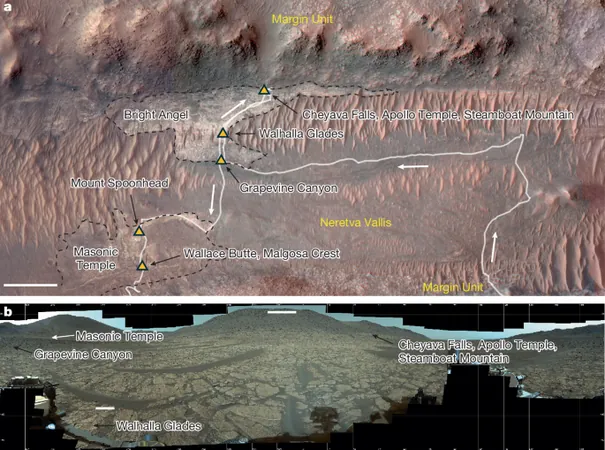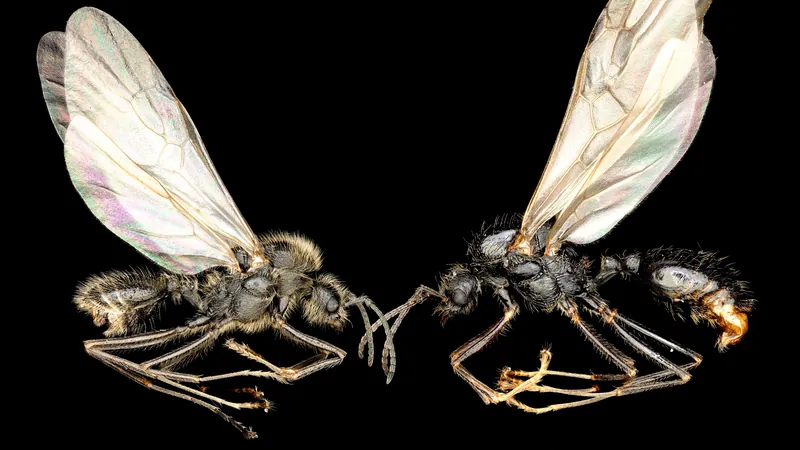
Unveiling the Secrets of Mars: Redox Processes and Organic Matter in Jezero Crater's Bright Angel Formation
2025-09-10
Author: Ying
Mysteries of Mars: Rock Textures and Their Implications
In a ground-breaking exploration of Mars' Bright Angel formation at Jezero Crater, scientists have observed a striking array of rock textures, primarily featuring a fine-grained component that dominates much of the structure. Although individual grains aren't discernible in the images, estimates reveal they range from 30 to 110 micrometers, classifying the rock primarily as mudstone.
Color Variations: A Clue to Mars’ Geological History
The rock colors vary from red to tan to grey, as captured in visible-light reflectance spectra from instruments like Mastcam-Z and SuperCam. High levels of ferric iron (Fe3+) contribute to the vivid red hues seen in some targeted areas, while rocks with lower Fe3+ give off lighter tones. This nuanced coloration highlights the varying compositions and geological processes that have shaped Mars.
Organic Matter Discovery: A Closer Look at Mars' Potential Life
In an exciting twist, organic matter was identified in specific mudstone targets within the Bright Angel formation. Detected by the SHERLOC instrument, these organic signatures, particularly a notable G band, suggest that Cheyava Falls, Walhalla Glades, and Apollo Temple areas could have hosted conditions suitable for life.
Composition Insights: What Lies Beneath?
Detailed analyses reveal the mudstone's rich silicate and iron content while lacking in manganese and magnesium. Interestingly, the observations show a consistent pattern in rock composition, suggesting a lack of high-temperature metamorphic processes in the region—signifying the rock’s formation under relatively mild conditions typical of ancient wet environments.
Unique Features: Poppy Seeds and Leopard Spots
Among the myriad features, scientists discovered round to irregular masses—affectionately termed 'poppy seeds'—that exhibit striking colors from black to dark green. Similarly, distinct 'leopard spots' with dark rims and lighter cores hint at a complex interplay of chemical processes at work, potentially relating to organic interactions.
Potential Biosignatures: What They Could Mean for Mars’ Past
With these observations, researchers are challenged to reconsider the organic matter's implications as potential biosignatures—evidence that nuances the narrative of Mars as a once habitable world. The interplay between redox processes, organic material, and mineral formations paints a compelling picture of a planet where life could have emerged.
Looking Forward: Future Investigations Needed
As the Perseverance rover continues its mission, questions about the origins and processes that shaped the Bright Angel formation remain. The pursuit of further samples from Mars could shed light on these intriguing minerals and organic compounds, fueling our quest to understand the potential for life beyond Earth.




 Brasil (PT)
Brasil (PT)
 Canada (EN)
Canada (EN)
 Chile (ES)
Chile (ES)
 Česko (CS)
Česko (CS)
 대한민국 (KO)
대한민국 (KO)
 España (ES)
España (ES)
 France (FR)
France (FR)
 Hong Kong (EN)
Hong Kong (EN)
 Italia (IT)
Italia (IT)
 日本 (JA)
日本 (JA)
 Magyarország (HU)
Magyarország (HU)
 Norge (NO)
Norge (NO)
 Polska (PL)
Polska (PL)
 Schweiz (DE)
Schweiz (DE)
 Singapore (EN)
Singapore (EN)
 Sverige (SV)
Sverige (SV)
 Suomi (FI)
Suomi (FI)
 Türkiye (TR)
Türkiye (TR)
 الإمارات العربية المتحدة (AR)
الإمارات العربية المتحدة (AR)